
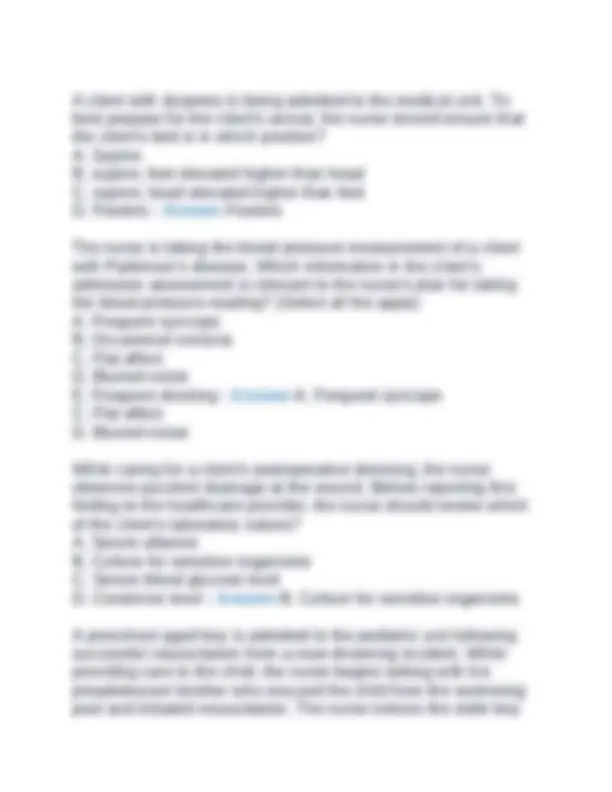
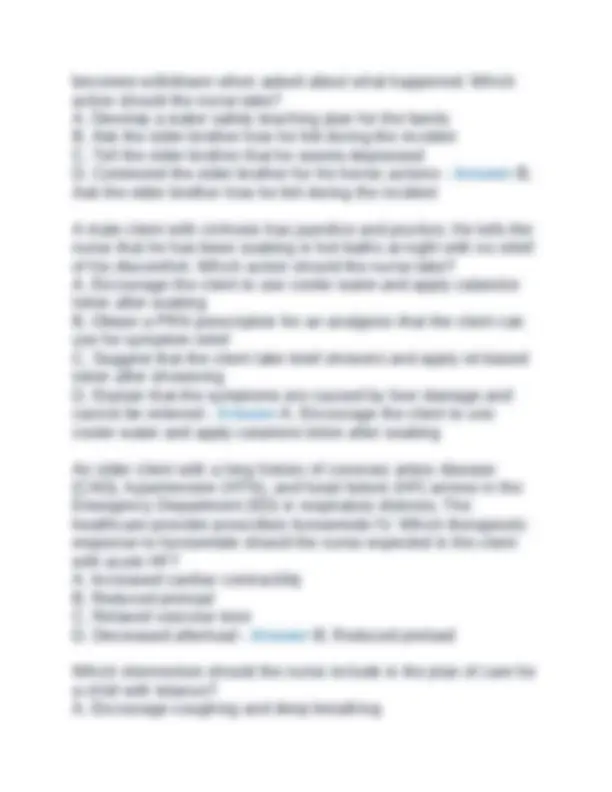
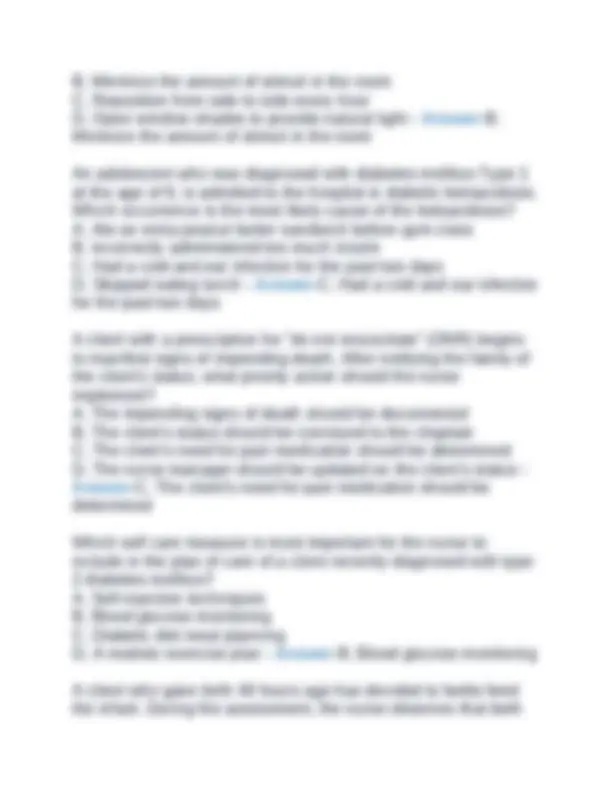
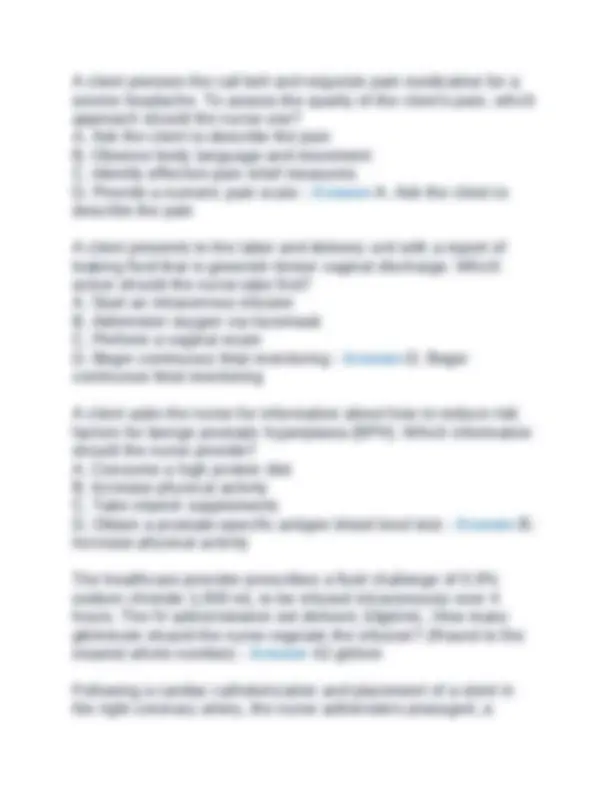
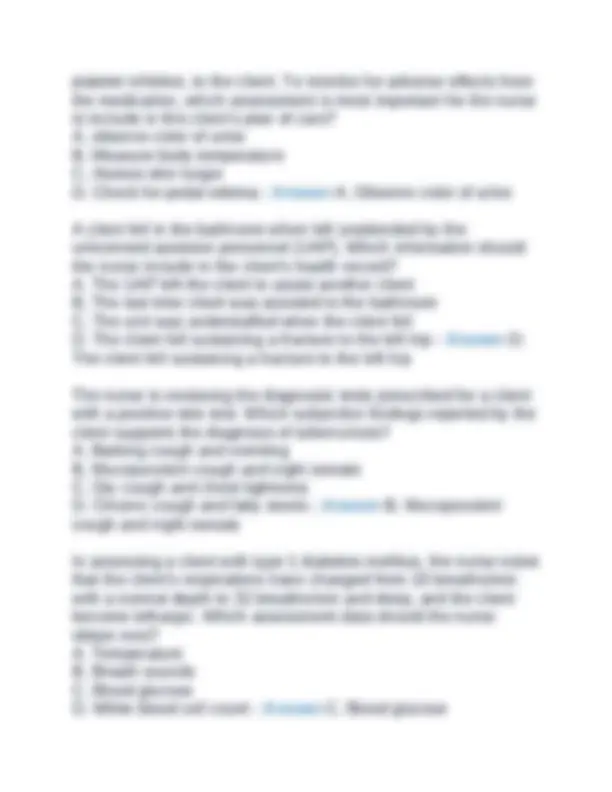
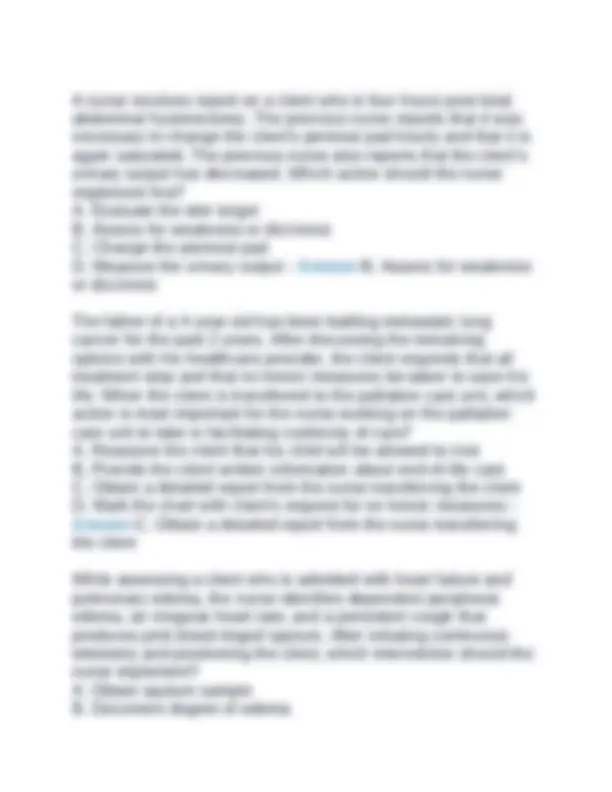
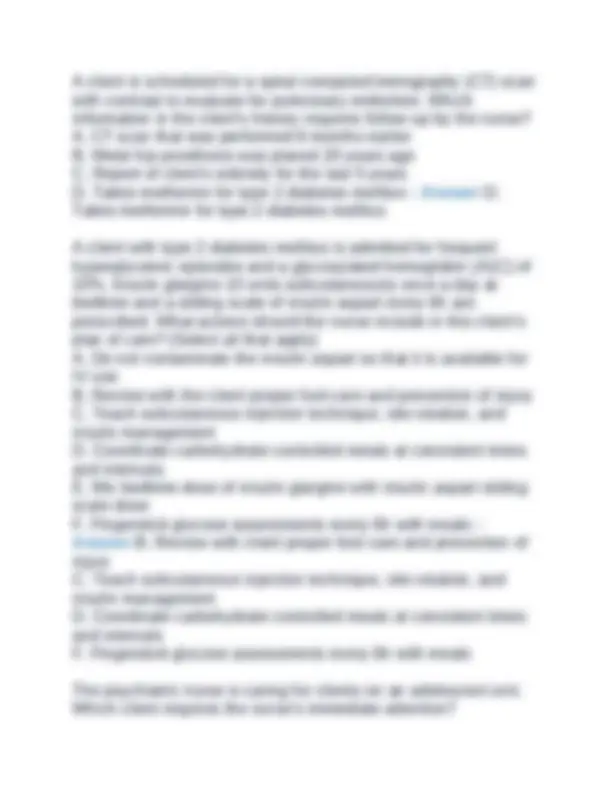
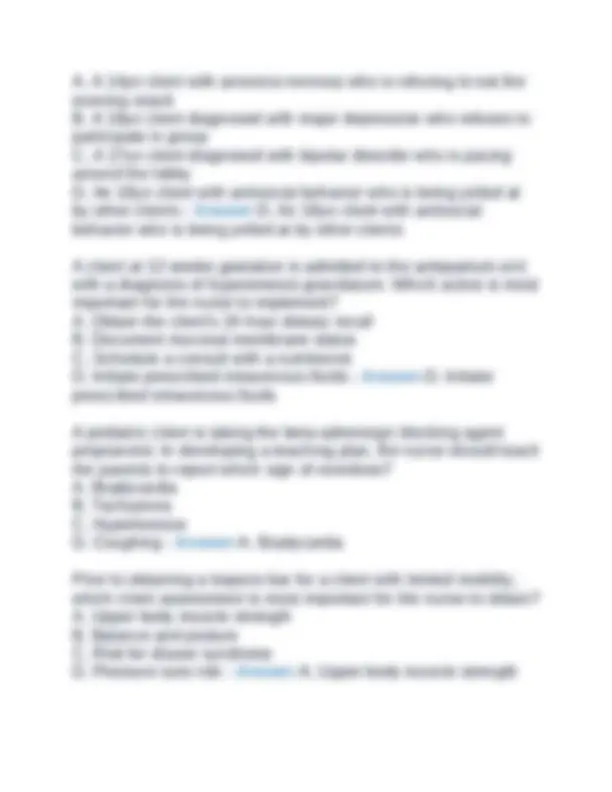
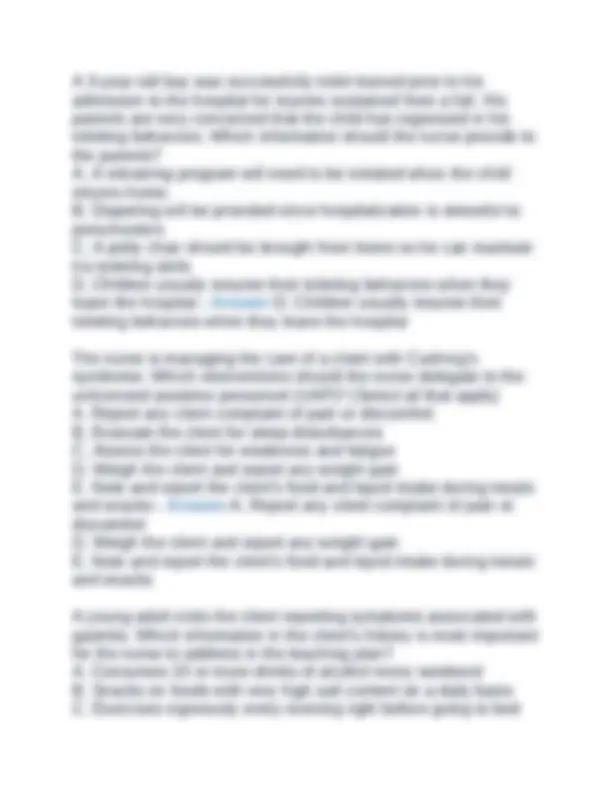
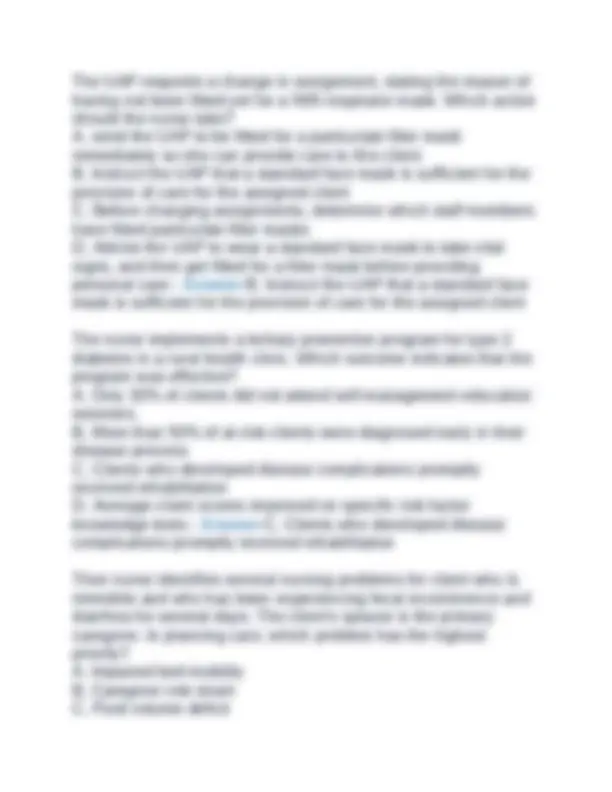
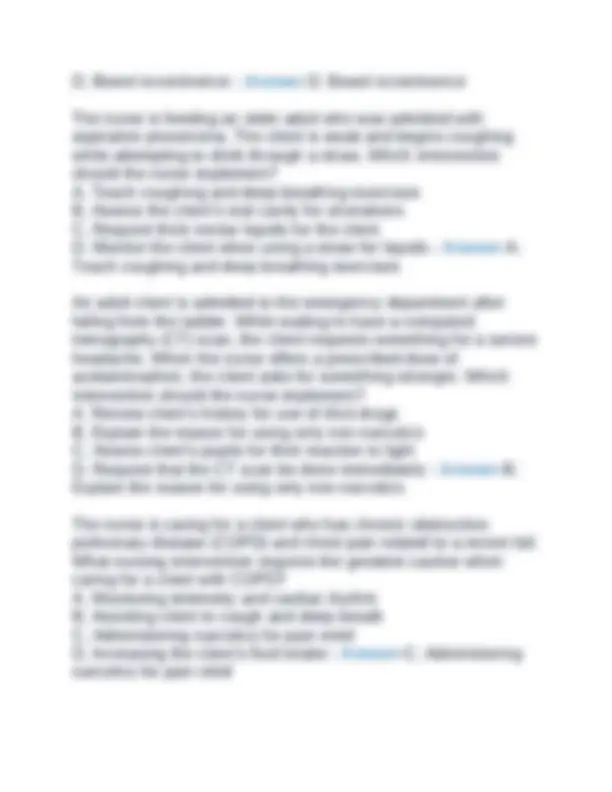
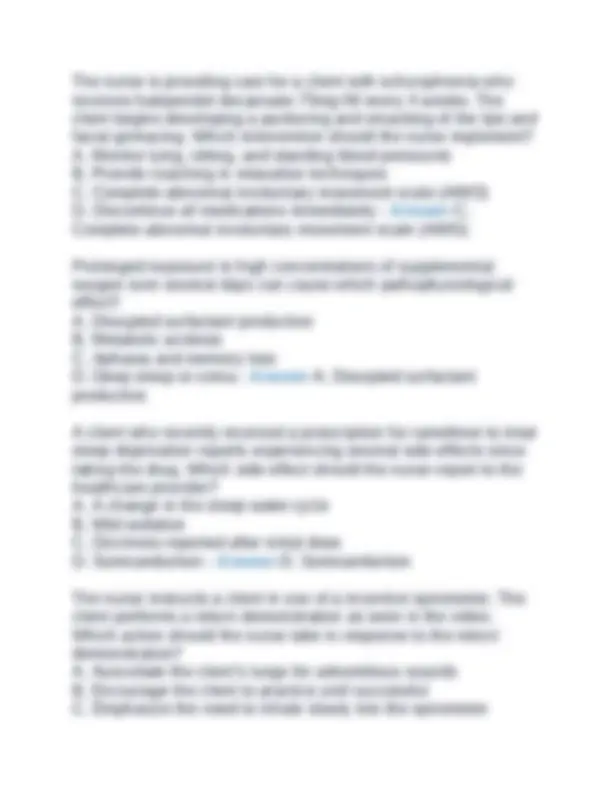
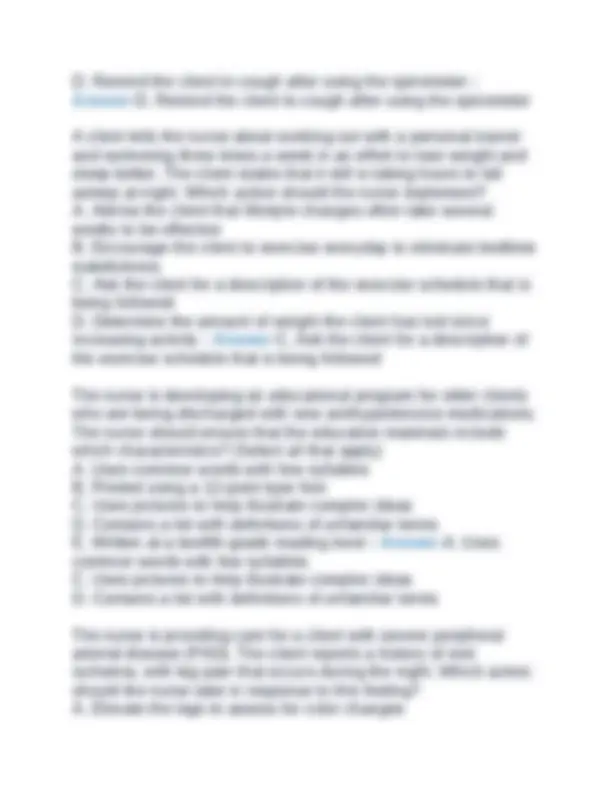
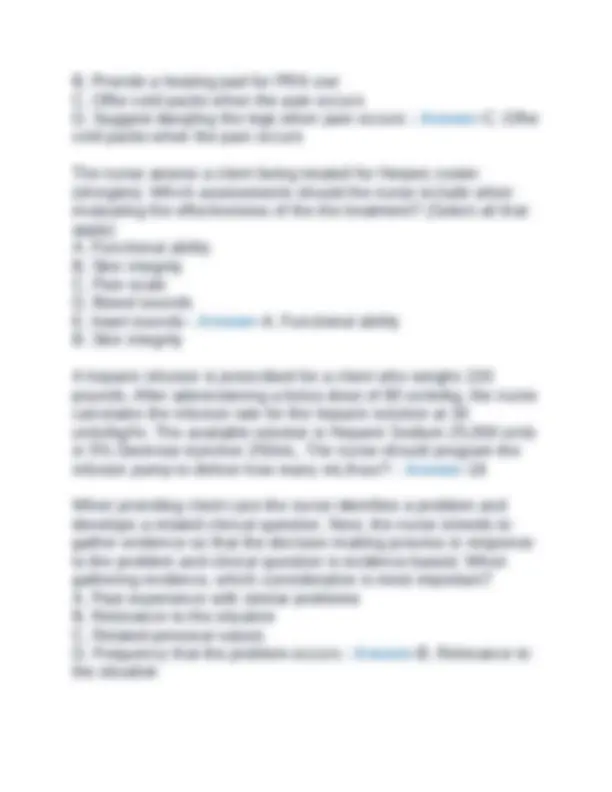
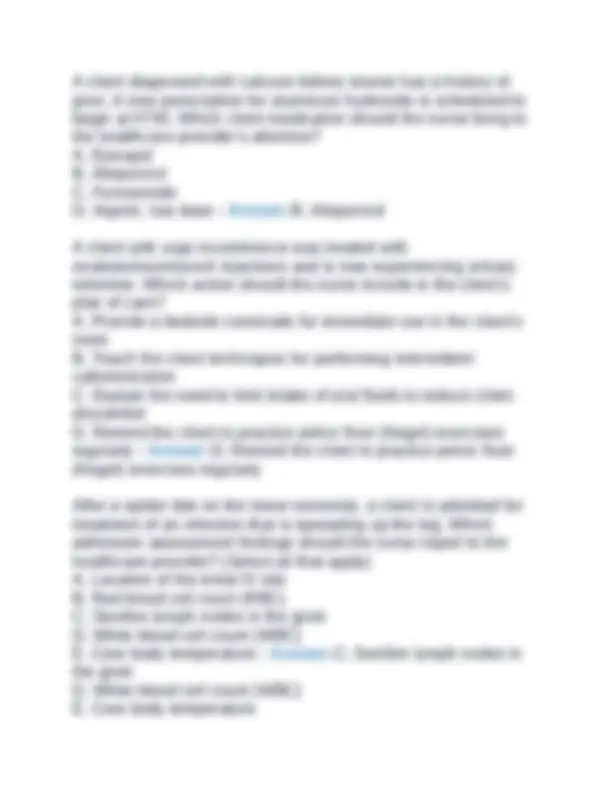
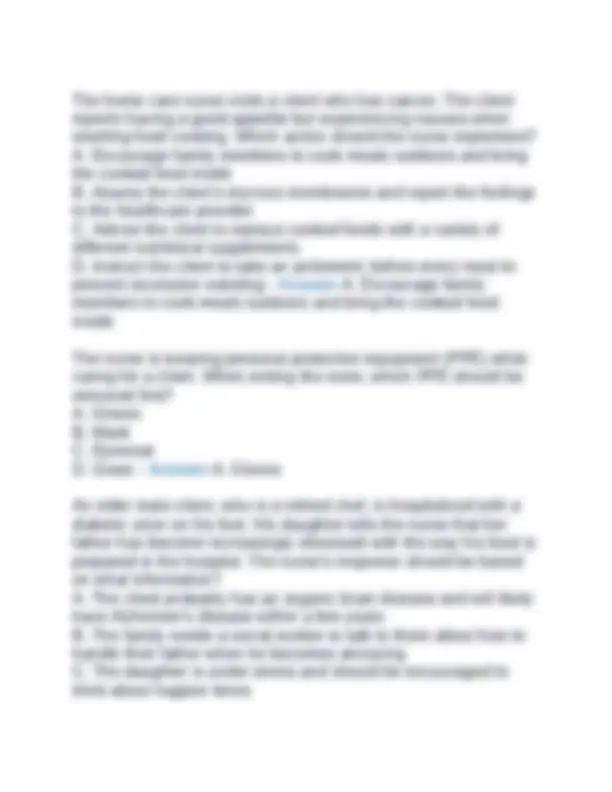
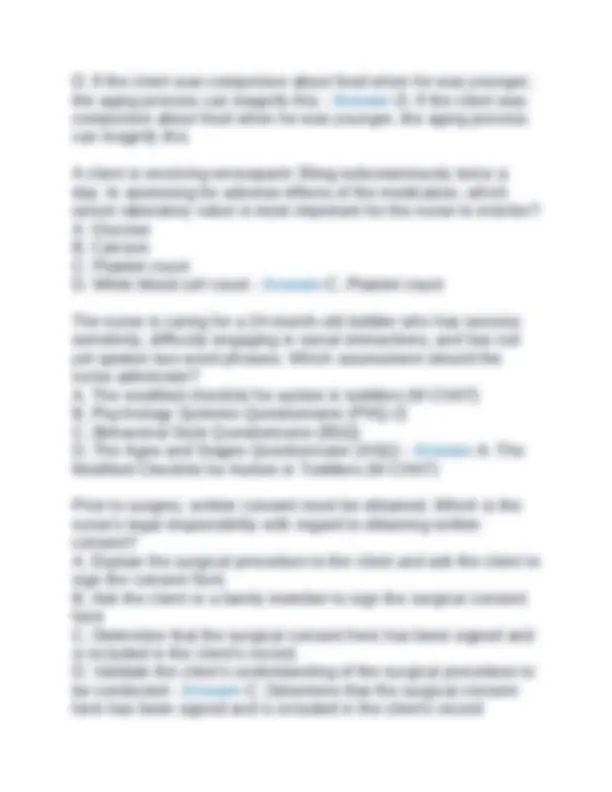
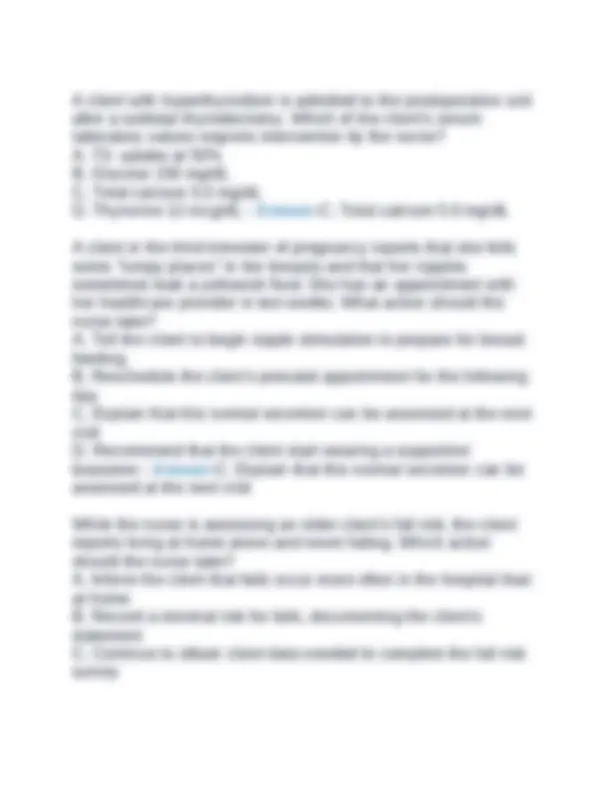
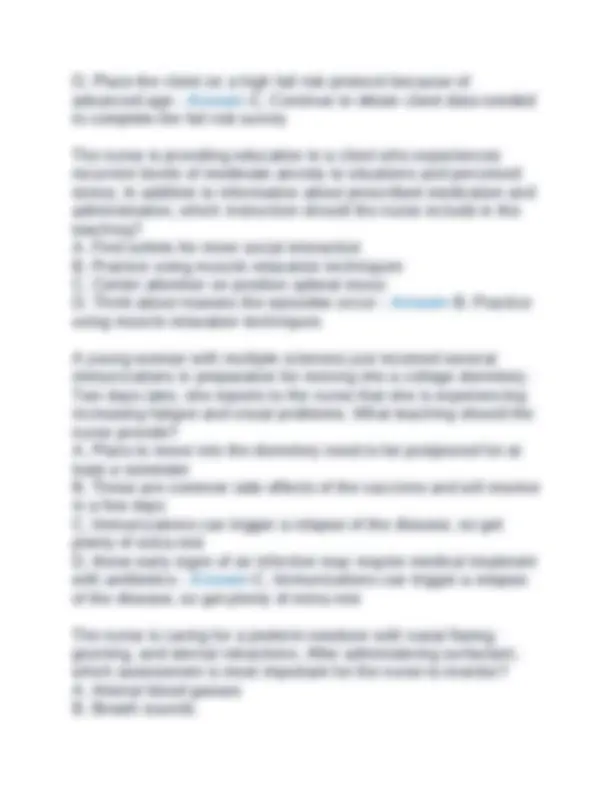
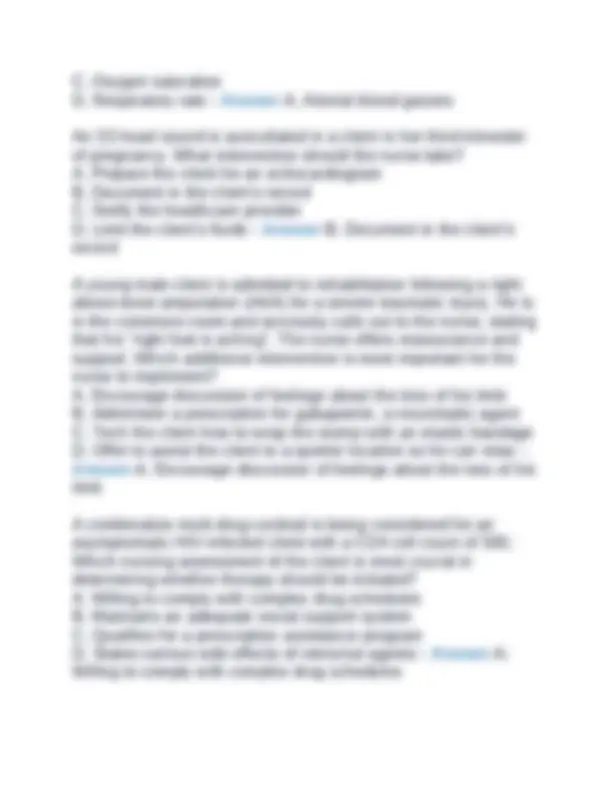
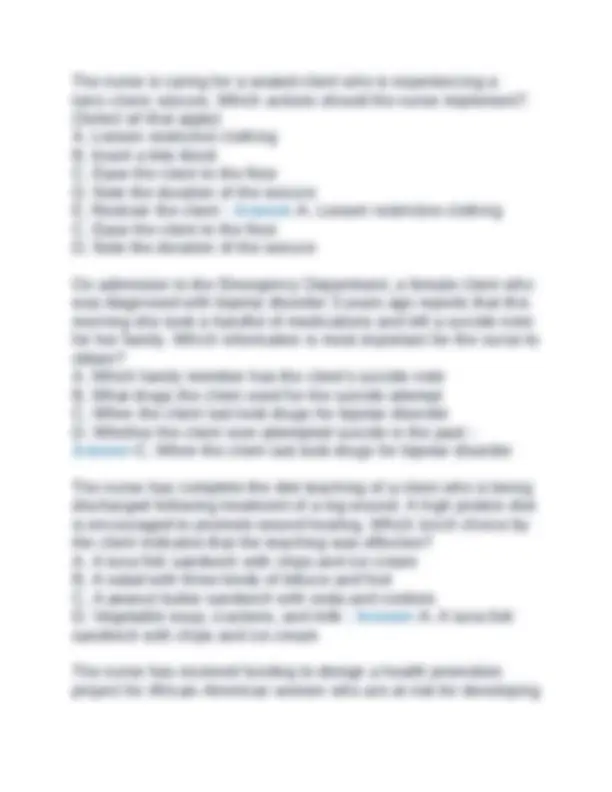
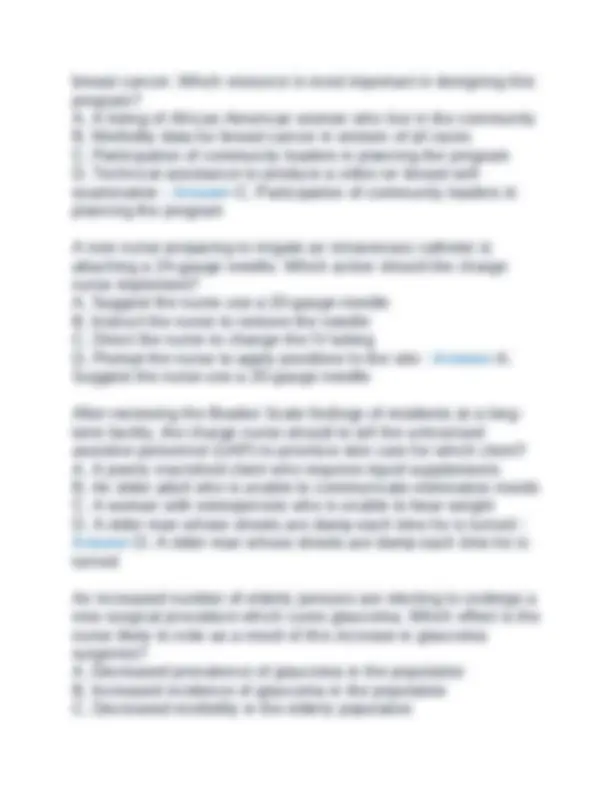
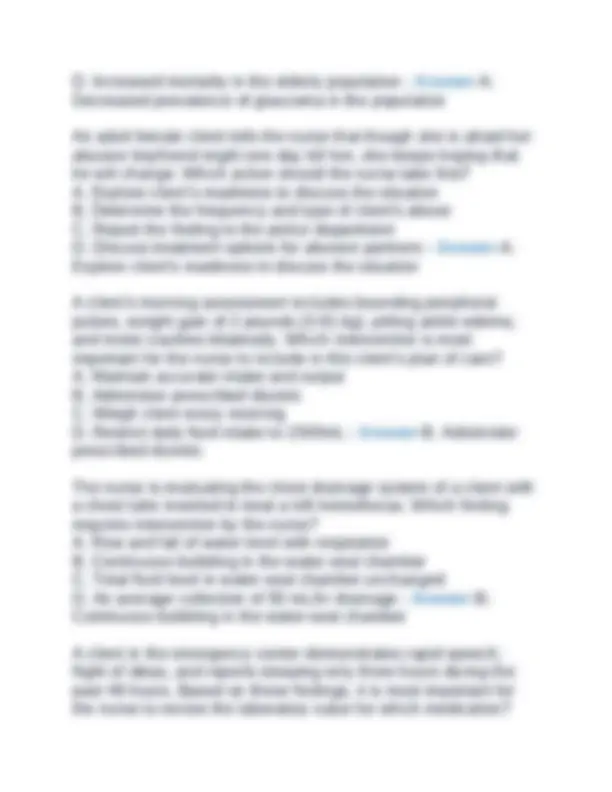
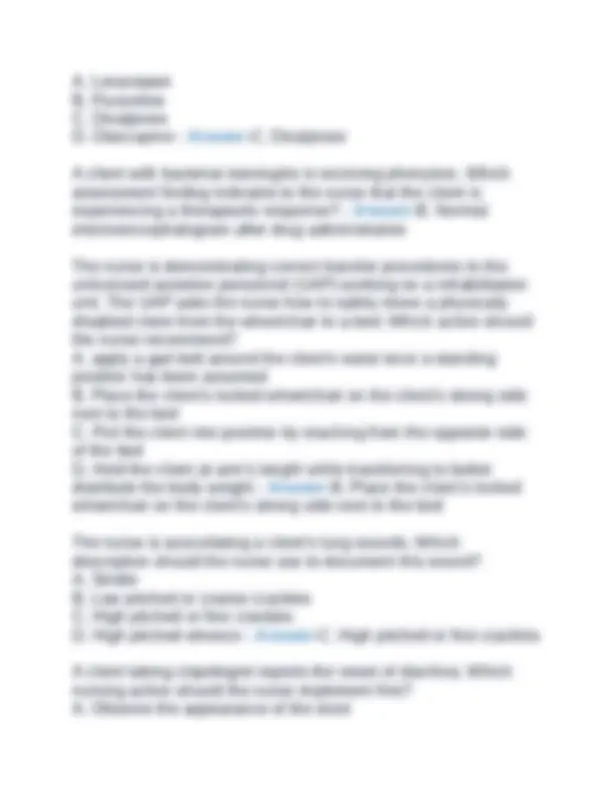
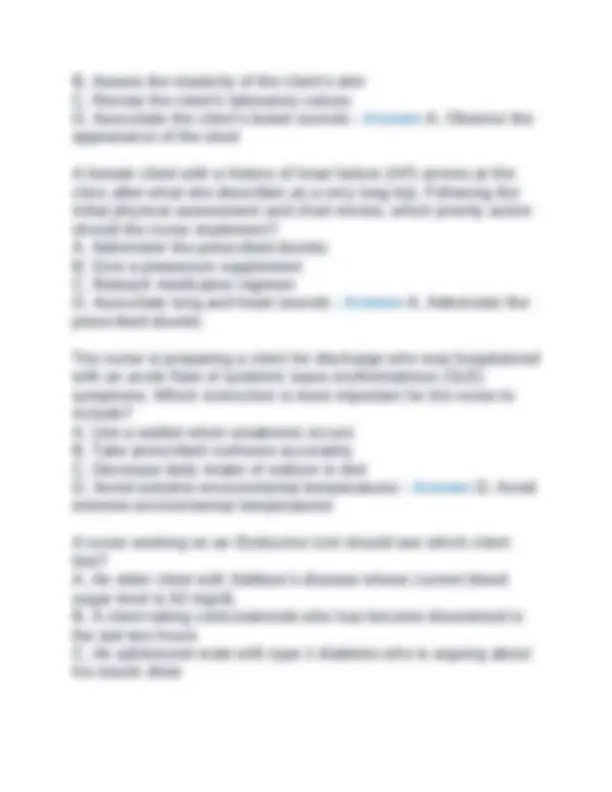
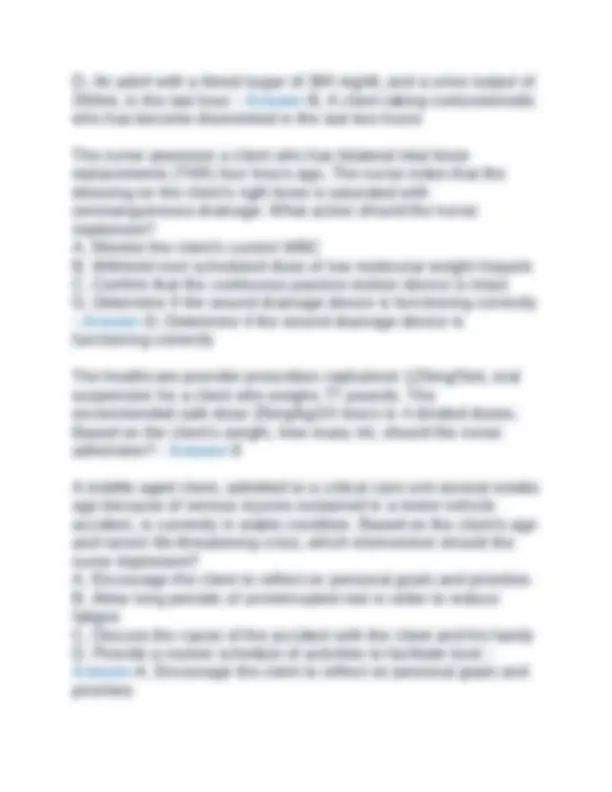
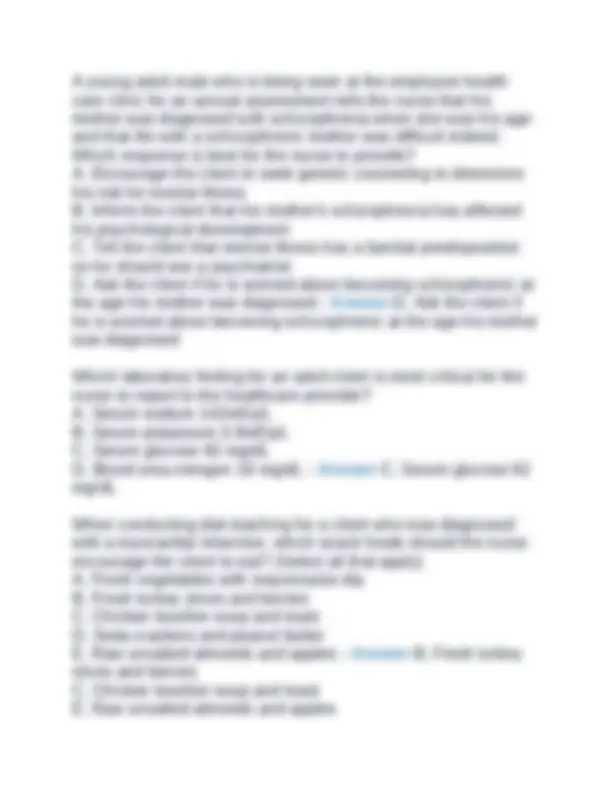
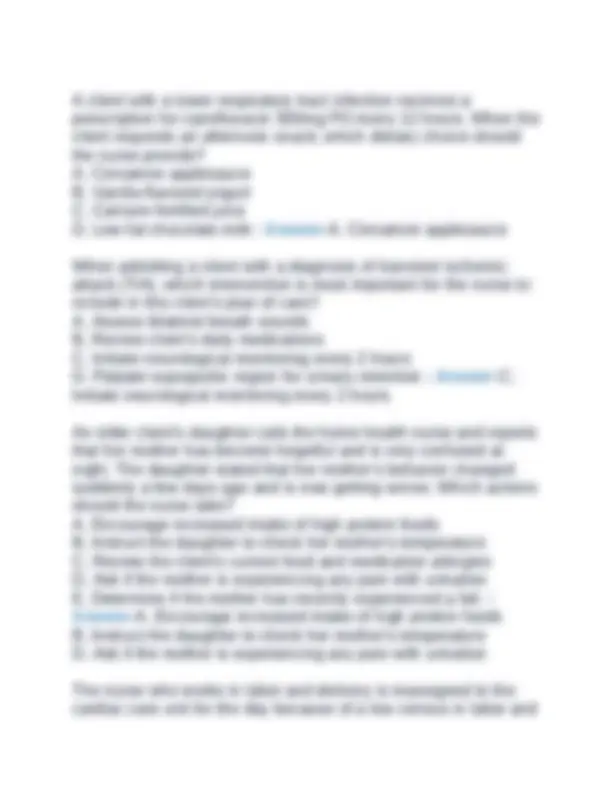

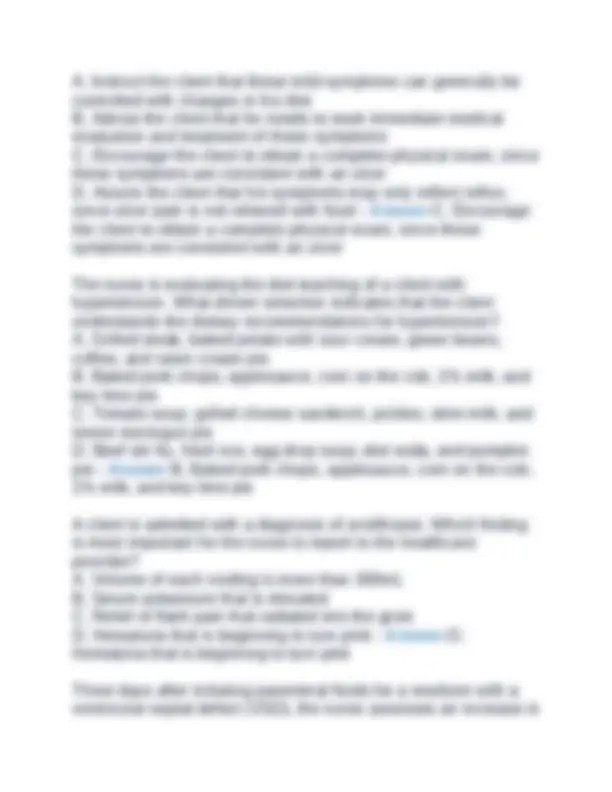
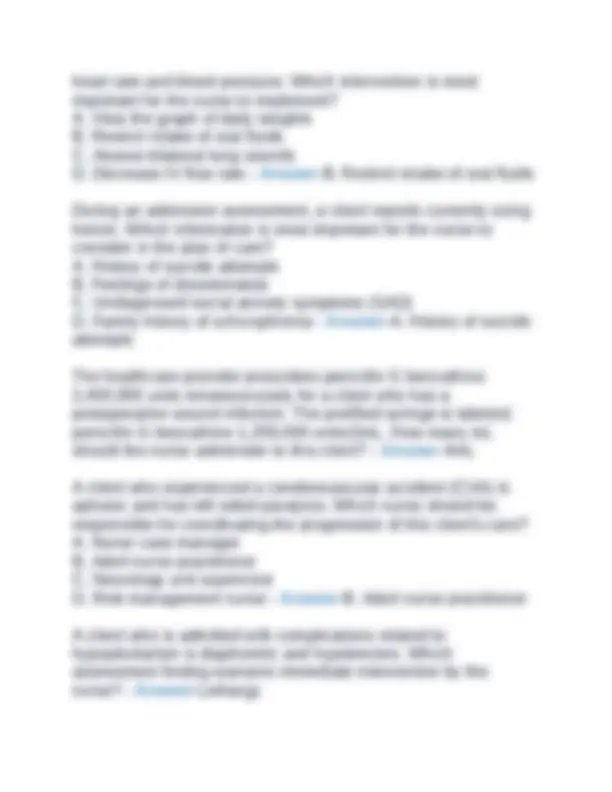
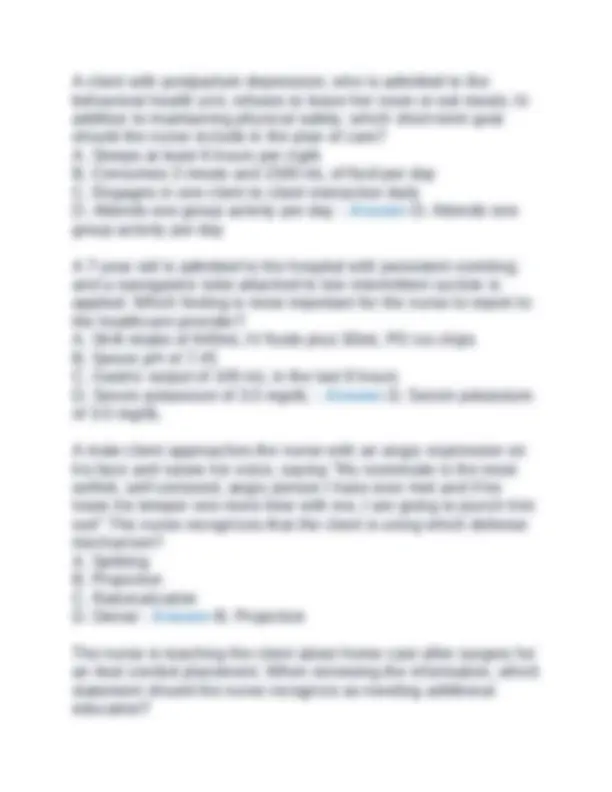
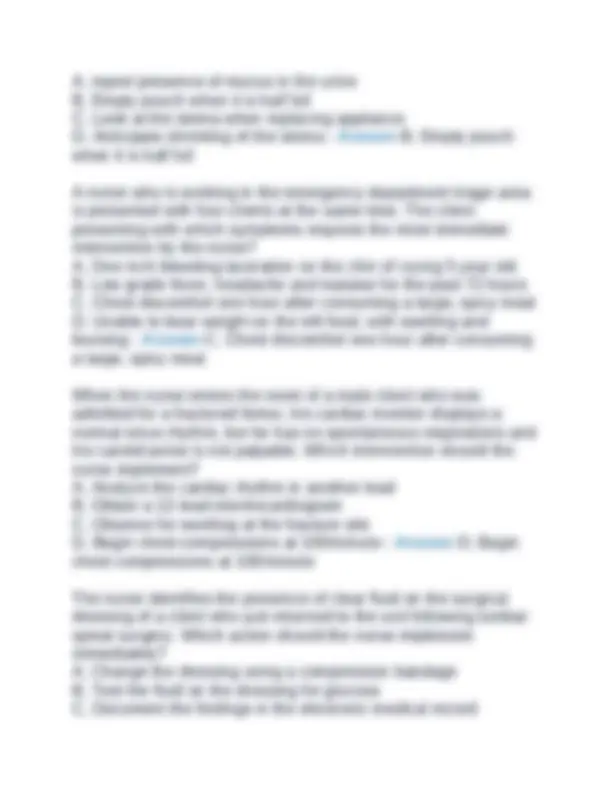
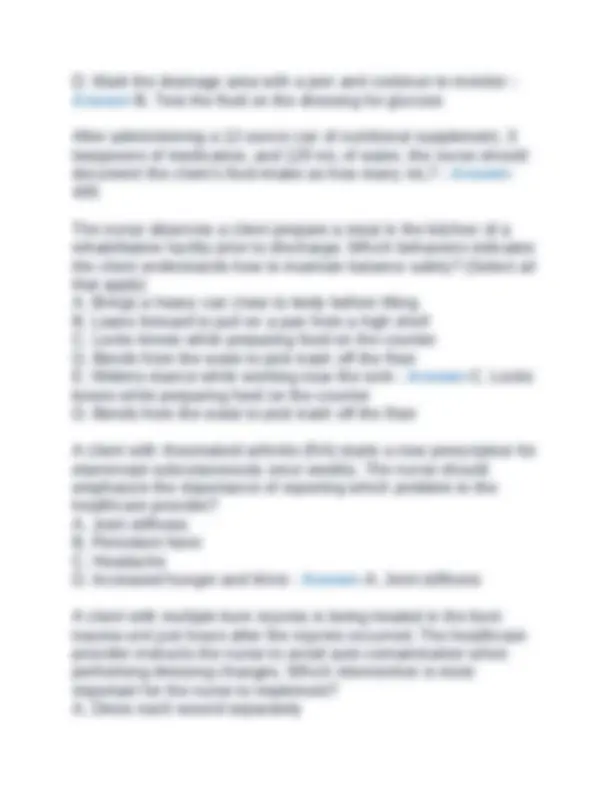
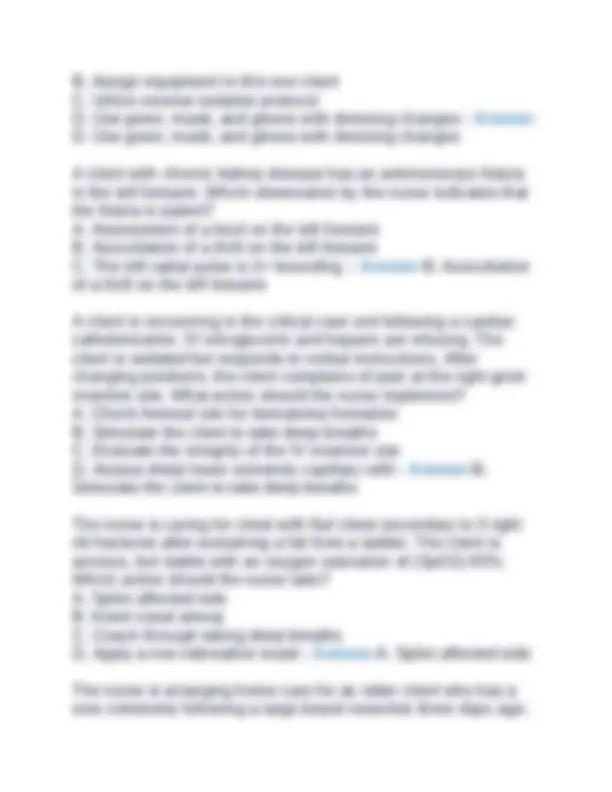
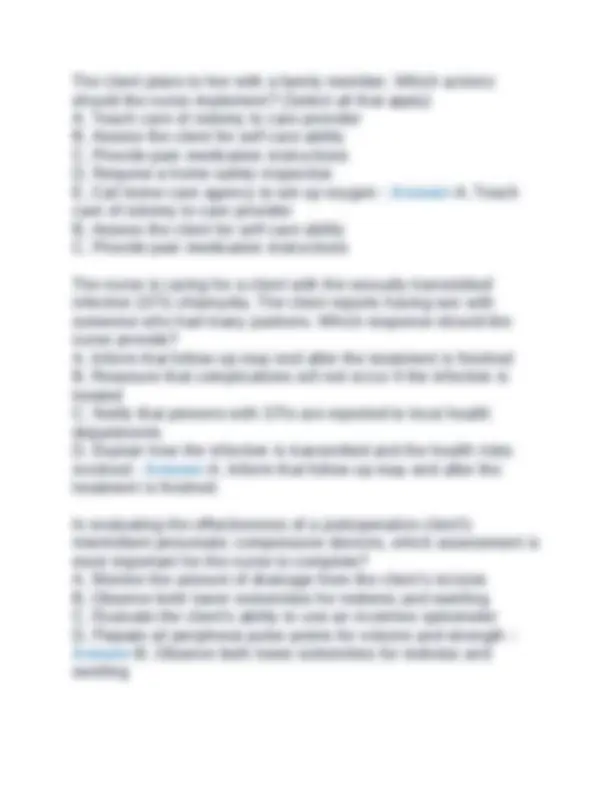
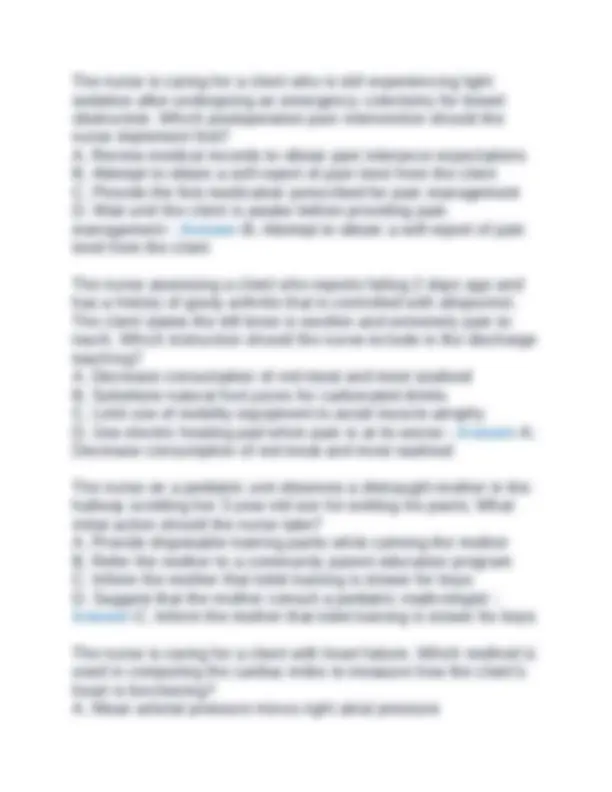
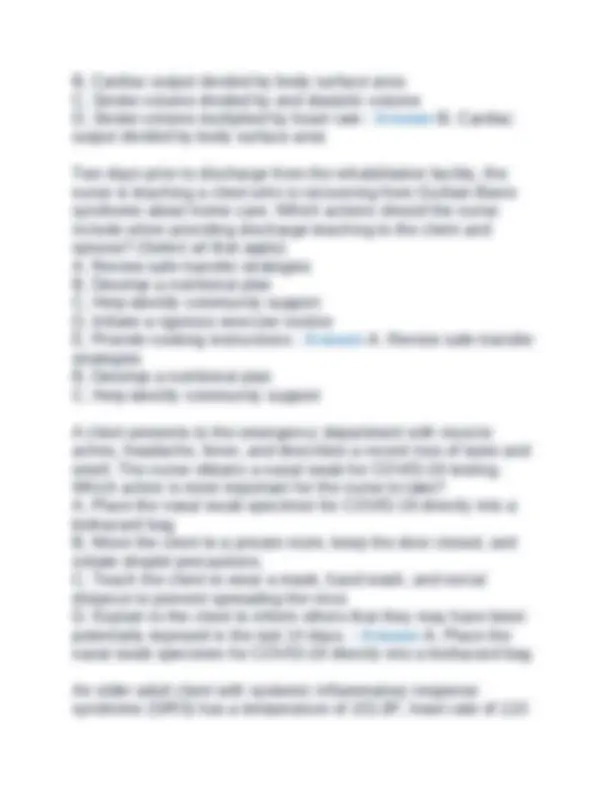
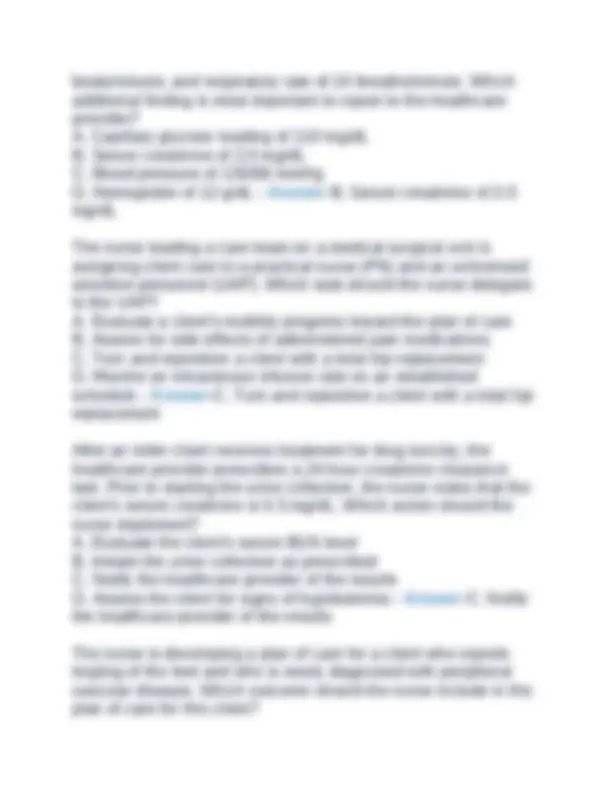
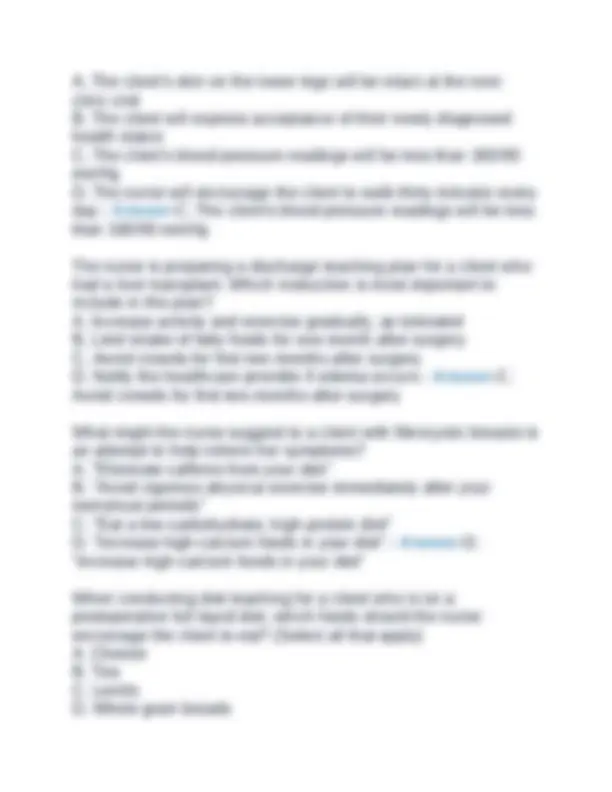
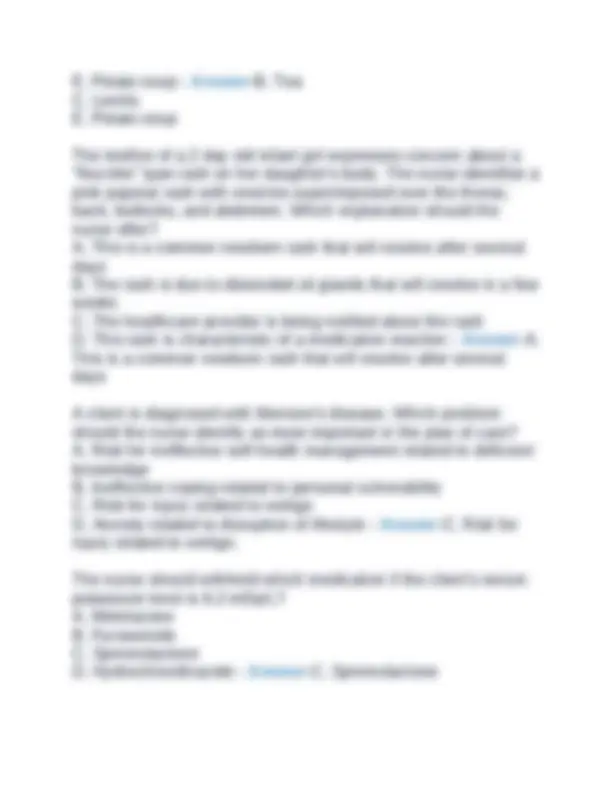


Study with the several resources on Docsity

Earn points by helping other students or get them with a premium plan


Prepare for your exams
Study with the several resources on Docsity

Earn points to download
Earn points by helping other students or get them with a premium plan
Community
Ask the community for help and clear up your study doubts
Discover the best universities in your country according to Docsity users
Free resources
Download our free guides on studying techniques, anxiety management strategies, and thesis advice from Docsity tutors
[Actual Exam] HESI EXIT EXAM LATEST 2025-2026 EXAM NEWEST 2 EXAM TEST BANK LATEST 2025 QUESTIONS WITH CORRECT ANSWERS WITH RATIONALES | GRADED A+. [Actual Exam] HESI EXIT EXAM LATEST 2025-2026 EXAM NEWEST 2 EXAM TEST BANK LATEST 2025 QUESTIONS WITH CORRECT ANSWERS WITH RATIONALES | GRADED A+.
Typology: Exams
1 / 49

This page cannot be seen from the preview
Don't miss anything!










































A female client presents in the emergency department and tells the nurse that she was raped last night. Which question is most important for the nurse to ask? A. Has she taken a bath since the rape occurred? B. Is the place where she lives a safe place? C. Does she know the person who raped her? D. Did she report the rape to the police department? - Answer -A. Has she taken a bath since the rape occurred? The nurse is completing the admission assessment of a 3-year old who is admitted with bacterial meningitis and hydrocephalus. Which assessment finding is evidence that the child is experiencing increased intracranial pressure (ICP)? A. Tachycardia and tachypnea B. Sluggish and unequal pupillary responses C. Increased head circumference and bulging fontanels D. Blood pressure fluctuations and syncope - Answer -B. Sluggish and unequal pupillary responses A client with acute pancreatitis is admitted with severe, piercing abdominal pain and an elevated serum amylase. Which additional information is the client most likely to report to the nurse? A. Abdominal pain decreases when lying supine B. Pain lasts an hour and leaves the abdomen tender C. Right upper quadrant pain refers to right scapula D. Drinks alcohol until intoxicated at least twice weekly. - Answer - A. Abdominal pain decreases when lying supine
A child newly diagnosed with sickle cell anemia (SCA) is being discharged from the hospital. Which information is most important for the nurse to provide the parents prior to discharge? A. Instructions about how much fluid the child should drink daily. B. Signs of addiction to opioid pain medications C. Information about non-pharmaceutical pain relief measures D. Referral for social services for the child and family - Answer -A. Instructions about how much fluid the child should drink daily To auscultate for a carotid bruit, the nurse places the stethoscope at what location. (Select the location on the image with a red dot).
becomes withdrawn when asked about what happened. Which action should the nurse take? A. Develop a water safety teaching plan for the family B. Ask the older brother how he felt during the incident C. Tell the older brother that he seems depressed D. Commend the older brother for his heroic actions - Answer -B. Ask the older brother how he felt during the incident A male client with cirrhosis has jaundice and pruritus. He tells the nurse that he has been soaking in hot baths at night with no relief of his discomfort. Which action should the nurse take? A. Encourage the client to use cooler water and apply calamine lotion after soaking B. Obtain a PRN prescription for an analgesic that the client can use for symptom relief C. Suggest that the client take brief showers and apply oil-based lotion after showering D. Explain that the symptoms are caused by liver damage and cannot be relieved - Answer -A. Encourage the client to use cooler water and apply calamine lotion after soaking An older client with a long history of coronary artery disease (CAD), hypertension (HTN), and heart failure (HF) arrives in the Emergency Department (ED) in respiratory distress. The healthcare provider prescribes furosemide IV. Which therapeutic response to furosemide should the nurse expected in the client with acute HF? A. Increased cardiac contractility B. Reduced preload C. Relaxed vascular tone D. Decreased afterload - Answer -B. Reduced preload Which intervention should the nurse include in the plan of care for a child with tetanus? A. Encourage coughing and deep breathing
B. Minimize the amount of stimuli in the room C. Reposition from side to side every hour D. Open window shades to provide natural light - Answer -B. Minimize the amount of stimuli in the room An adolescent who was diagnosed with diabetes mellitus Type 1 at the age of 9, is admitted to the hospital in diabetic ketoacidosis. Which occurrence is the most likely cause of the ketoacidosis? A. Ate an extra peanut butter sandwich before gym class B. incorrectly administered too much insulin C. Had a cold and ear infection for the past two days D. Skipped eating lunch - Answer -C. Had a cold and ear infection for the past two days A client with a prescription for "do not resuscitate" (DNR) begins to manifest signs of impending death. After notifying the family of the client's status, what priority action should the nurse implement? A. The impending signs of death should be documented B. The client's status should be conveyed to the chaplain C. The client's need for pain medication should be determined D. The nurse manager should be updated on the client's status - Answer -C. The client's need for pain medication should be determined Which self care measure is most important for the nurse to include in the plan of care of a client recently diagnosed with type 2 diabetes mellitus? A. Self-injection techniques B. Blood glucose monitoring C. Diabetic diet meal planning D. A realistic exercise plan - Answer -B. Blood glucose monitoring A client who gave birth 48 hours ago has decided to bottle feed the infant. During the assessment, the nurse observes that both
procedure. In preparing the client for the procedure, which intervention has the highest priority? A. Allow client to gargle with warm salt water B. Administer a sedative to alleviate anxiety C. Instruct client to write down the questions D. Deny client's request for a midnight snack - Answer -C. Instruct client to write down the questions The nurse assesses a client one hour after starting a transfusion of packed red blood cells and determines that there are no indications of a transfusion reaction. What instruction should the nurse provide the unlicensed assistive personnel (UAP) who is working with the nurse? A. Notify the nurse when the transfusion has finished, so further client assessment can be done B. Continue to measure the client's vital signs every thirty minutes until the transfusion is complete C. Monitor the client carefully for the next three hours and report the onset of a reaction immediately D. Since a reaction did not occur, the priority is to maintain client comfort during the transfusion - Answer -B. Continue to measure the client's vital signs every thirty minutes until the transfusion is complete The healthcare provider prescribes a sepsis protocol for a client with multi-organ failure caused by a ruptured appendix. Which intervention is most important for the nurse to include in the plan of care? A. Assess warmth of extremities B. Keep head of bed raised 45 degrees C. Monitor blood glucose level D. Maintain strict intake and output - Answer -D. Maintain strict intake and output
A client presses the call bell and requests pain medication for a severe headache. To assess the quality of the client's pain, which approach should the nurse use? A. Ask the client to describe the pain B. Observe body language and movement C. Identify effective pain relief measures D. Provide a numeric pain scale - Answer -A. Ask the client to describe the pain A client presents to the labor and delivery unit with a report of leaking fluid that is greenish-brown vaginal discharge. Which action should the nurse take first? A. Start an intravenous infusion B. Administer oxygen via facemask C. Perform a vaginal exam D. Begin continuous fetal monitoring - Answer -D. Begin continuous fetal monitoring A client asks the nurse for information about how to reduce risk factors for benign prostatic hyperplasia (BPH). Which information should the nurse provide? A. Consume a high protein diet B. Increase physical activity C. Take vitamin supplements D. Obtain a prostate-specific antigen blood level test - Answer -B. Increase physical activity The healthcare provider prescribes a fluid challenge of 0.9% sodium chloride 1,000 mL to be infused intravenously over 4 hours. The IV administration set delivers 10gtt/mL. How many gtt/minute should the nurse regulate the infusion? (Round to the nearest whole number) - Answer -42 gtt/min Following a cardiac catheterization and placement of a stent in the right coronary artery, the nurse administers prasugrel, a
A nurse receives report on a client who is four hours post-total abdominal hysterectomy. The previous nurse reports that it was necessary to change the client's perineal pad hourly and that it is again saturated. The previous nurse also reports that the client's urinary output has decreased. Which action should the nurse implement first? A. Evaluate the skin turgor B. Assess for weakness or dizziness C. Change the perineal pad D. Measure the urinary output - Answer -B. Assess for weakness or dizziness The father of a 4-year-old has been battling metastatic lung cancer for the past 2 years. After discussing the remaining options with his healthcare provider, the client requests that all treatment stop and that no heroic measures be taken to save his life. When the client is transferred to the palliative care unit, which action is most important for the nurse working on the palliative care unit to take in facilitating continuity of care? A. Reassure the client that his child will be allowed to visit B. Provide the client written information about end-of-life care C. Obtain a detailed report from the nurse transferring the client D. Mark the chart with client's request for no heroic measures - Answer -C. Obtain a detailed report from the nurse transferring the client While assessing a client who is admitted with heart failure and pulmonary edema, the nurse identifies dependent peripheral edema, an irregular heart rate, and a persistent cough that produces pink blood-tinged sputum. After initiating continuous telemetry and positioning the client, which intervention should the nurse implement? A. Obtain sputum sample B. Document degree of edema
C. Initiate hourly urine output measurement D. Administer intravenous diuretics - Answer -A. Obtain sputum sample A client who is admitted for primary hypothyroidism has early signs of myxedema coma. In assessing the client, in which sequence should the nurse complete these actions? (descending order) - Answer -1. Observe breathing patterns
A client is scheduled for a spiral computed tomography (CT) scan with contrast to evaluate for pulmonary embolism. Which information in the client's history requires follow-up by the nurse? A. CT scan that was performed 6 months earlier B. Metal hip prosthesis was placed 20 years ago C. Report of client's sobriety for the last 5 years D. Takes metformin for type 2 diabetes mellitus - Answer -D. Takes metformin for type 2 diabetes mellitus A client with type 2 diabetes mellitus is admitted for frequent hyperglycemic episodes and a glycosylated hemoglobin (A1C) of 10%. Insulin glargine 10 units subcutaneously once a day at bedtime and a sliding scale of insulin aspart every 6h are prescribed. What actions should the nurse include in this client's plan of care? (Select all that apply) A. Do not contaminate the insulin aspart so that it is available for IV use B. Review with the client proper foot care and prevention of injury C. Teach subcutaneous injection technique, site rotation, and insulin management D. Coordinate carbohydrate controlled meals at consistent times and intervals. E. Mix bedtime dose of insulin glargine with insulin aspart sliding scale dose F. Fingerstick glucose assessments every 6h with meals - Answer -B. Review with client proper foot care and prevention of injury C. Teach subcutaneous injection technique, site rotation, and insulin management D. Coordinate carbohydrate controlled meals at consistent times and intervals F. Fingerstick glucose assessments every 6h with meals The psychiatric nurse is caring for clients on an adolescent unit. Which client requires the nurse's immediate attention?
A. A 14yo client with anorexia nervosa who is refusing to eat the evening snack B. A 16yo client diagnosed with major depression who refuses to participate in group C. A 17yo client diagnosed with bipolar disorder who is pacing around the lobby D. An 18yo client with antisocial behavior who is being yelled at by other clients - Answer -D. An 18yo client with antisocial behavior who is being yelled at by other clients A client at 12 weeks gestation is admitted to the antepartum unit with a diagnosis of hyperemesis gravidarum. Which action is most important for the nurse to implement? A. Obtain the client's 24-hour dietary recall B. Document mucosal membrane status C. Schedule a consult with a nutritionist D. Initiate prescribed intravenous fluids - Answer -D. Initiate prescribed intravenous fluids A pediatric client is taking the beta-adrenergic blocking agent propranolol. In developing a teaching plan, the nurse should teach the parents to report which sign of overdose? A. Bradycardia B. Tachypnea C. Hypertension D. Coughing - Answer -A. Bradycardia Prior to obtaining a trapeze bar for a client with limited mobility, which client assessment is most important for the nurse to obtain? A. Upper body muscle strength B. Balance and posture C. Risk for disuse syndrome D. Pressure sore risk - Answer -A. Upper body muscle strength
D. Recently became a vegetarian and eats a lot of high fiber foods - Answer -A. Consumes 10 or more drinks of alcohol every weekend After administering a proton pump inhibitor (PPI), which action should the nurse take to evaluate the effectiveness of the medication? A. Auscultate for bowel sounds in all quadrants B. Ask the client about gastrointestinal pain C. Monitor the client's serum electrolyte levels D. Measure the client's fluid intake and output - Answer -B. Ask the client about gastrointestinal pain When assessing a recently delivered, multigravida client, the nurse finds that her vaginal bleeding is more than expected. Which factor in this client's history is related to this finding? A. The second stage of labor lasted 10 minutes B. She received butorphanol 2mg IVP during labor C. She is over 35 years of age D. She is a gravida 6, para 5 - Answer -D. She is a gravida 6, para 5 When assessing an IV site that is used for fluid replacement and medication administration, the client complains of tenderness when the arm is touched above the site. Which additional assessment finding warrants immediate intervention by the nurse? A. Client uses the arm cautiously B. Red streak tracking the vein C. A sluggish blood return D. Spot of dried blood at insertion site - Answer -B. Red streaks tracking the vein An older adult male reporting abdominal pain is admitted to the hospital from a long-term care facility. It has been 7 days since his
last bowel movement, his abdomen is distended, and he just vomited 150mL of dark brown emesis. In what order should the nurse implement these interventions? (Highest to lowest priority) - Answer -1. Send emesis sample to the lab
D. Bowel incontinence - Answer -D. Bowel incontinence The nurse is feeding an older adult who was admitted with aspiration pneumonia. The client is weak and begins coughing while attempting to drink through a straw. Which intervention should the nurse implement? A. Teach coughing and deep breathing exercises B. Assess the client's oral cavity for ulcerations C. Request thick nectar liquids for the client D. Monitor the client when using a straw for liquids - Answer -A. Teach coughing and deep breathing exercises An adult client is admitted to the emergency department after falling from the ladder. While waiting to have a computed tomography (CT) scan, the client requests something for a severe headache. When the nurse offers a prescribed dose of acetaminophen, the client asks for something stronger. Which intervention should the nurse implement? A. Review client's history for use of illicit drugs B. Explain the reason for using only non-narcotics C. Assess client's pupils for their reaction to light D. Request that the CT scan be done immediately - Answer -B. Explain the reason for using only non-narcotics The nurse is caring for a client who has chronic obstructive pulmonary disease (COPD) and chest pain related to a recent fall. What nursing intervention requires the greatest caution when caring for a client with COPD? A. Monitoring telemetry and cardiac rhythm B. Assisting client to cough and deep breath C. Administering narcotics for pain relief D. Increasing the client's fluid intake - Answer -C. Administering narcotics for pain relief
The nurse is providing care for a client with schizophrenia who receives haloperidol decanoate 75mg IM every 4 weeks. The client begins developing a puckering and smacking of the lips and facial grimacing. Which intervention should the nurse implement? A. Monitor lying, sitting, and standing blood pressures B. Provide coaching in relaxation techniques C. Complete abnormal involuntary movement scale (AIMS) D. Discontinue all medications immediately - Answer -C. Complete abnormal involuntary movement scale (AIMS) Prolonged exposure to high concentrations of supplemental oxygen over several days can cause which pathophysiological effect? A. Disrupted surfactant production B. Metabolic acidosis C. Aphasia and memory loss D. Deep sleep or coma - Answer -A. Disrupted surfactant production A client who recently received a prescription for ramelteon to treat sleep deprivation reports experiencing several side effects since taking the drug. Which side effect should the nurse report to the healthcare provider? A. A change in the sleep-wake cycle B. Mild sedation C. Dizziness reported after initial dose D. Somnambulism - Answer -D. Somnambulism The nurse instructs a client in use of a incentive spirometer. The client performs a return demonstration as seen in the video. Which action should the nurse take in response to the return demonstration? A. Auscultate the client's lungs for adventitious sounds B. Encourage the client to practice until successful C. Emphasize the need to inhale slowly into the spirometer